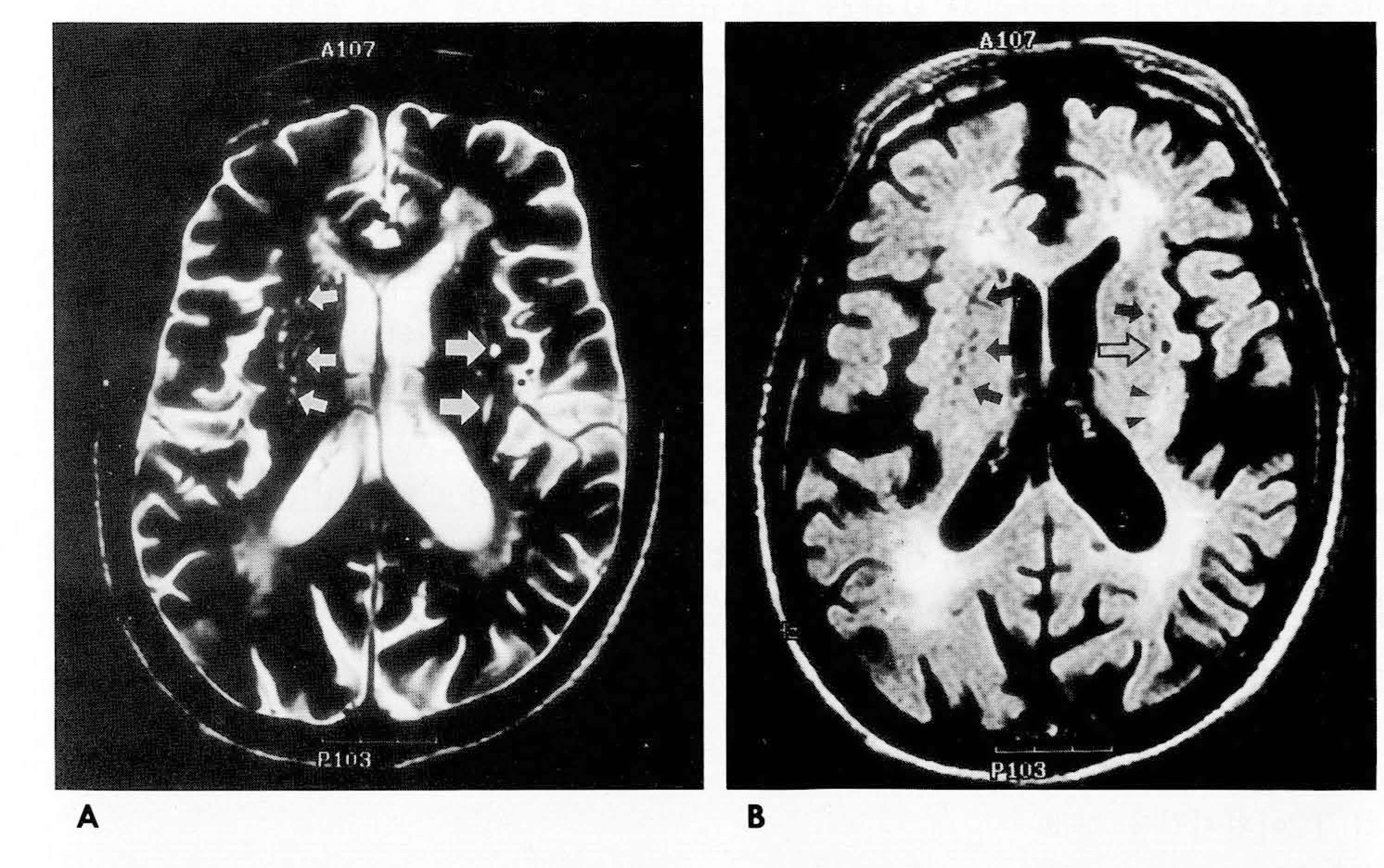J Korean Radiol Soc.
1998 Mar;38(3):397-401. 10.3348/jkrs.1998.38.3.397.
MR Imaging with FLAIR Pulse Sequence in Various Cerebral Lesions: Comparison with T2-Weighted Imaging
- Affiliations
-
- 1Department of Diagnostic Radiology, Kangnam General Hospital Public Coporation.
- 2Department of Radiology, Iwate University College of Medicine, Japan.
- KMID: 2201392
- DOI: http://doi.org/10.3348/jkrs.1998.38.3.397
Abstract
-
PURPOSE: To evaluate the utility of fluid-attenuated inversion recovery(FLAIR) sequence by comparing thesignal intensities in various cerebral lesions with those on T2-weighted MR imaging.
MATERIALS & METHODS: In 41patients who showed different signal intensities between T2-weighted images and FLAIR sequences, we reviewed theVirchow-Robin space(VRS), acute or chronic infarctions including lacunar cavities, and postoperativeencephalomalacia. In all patients, the location, shape and size of abnormal signal intensities were evaluated.
RESULTS
The hyperintensities of VRS and lacunar infarctions on T2-weighted imaging appeared as hypointensitieson FLAIR imaging. The hyperintense rims or crescents around lacunar cavities were only detected on FLAIR imaging.The extent of acute and chronic infarctions with homogenous hyperintensities seen on T2-weighted images was welldelineated on FLAIR imaging. Postoperative encephalomalacia and adjacent lesions showed low and high signalintensities, respectively, on FLAIR imaging, though they were hyperintense on T2-weighted images.
CONCLUSION
ForVRS, infarction and encephalomalacia, FLAIR provides images that are superior to T2-weighted images, and may thusbe useful as an additional MR sequence in various cerebral lesions.
Figure
Reference
-
1.이상현, 장기현, 박홍석등. 뇌질환의진단에있어서FLAIRMR sequence의임상적유용성. 대한방사선의학희지. 1997. 37:1–7.2.Zawadzki MB., Atkinson D., Debtrick Μ, et al. Fluid-Attenuated Inversion Recovery (FLAIR) for assessment of cerebral infarction. Stroke. 1996. 27:1187–1191.
Article3.Coene BD., Hanjnal JV., Pennock JM, et al. MRI of the brain stem using fluid-attenuated inversion recovery pulse sequences. Neuroradiology. 1996. 35:327–331.4.Alexander JA., Sheppard S., Davis PC, et al. Adult Cerebrovascular Diease: Role of Modified Rapid Fluid-Attenuated Inversion-Recovery Sequence. AJNR. 1996. 17:1507–1513.5.Tsuchiya K., Mizutani Y., Hachiya J. Preliminary Evaluation of Fluid-Attenuated Inversion-Recovery MR in the Diagnosis of intracranial tumors. AJNR. 1996. 17:1081–1086.6.Rydberg JN., Hammond CA., Grim RC, et al. Initial Clinical Experience in MR Imaging of the Brain with a Fast Fluid-attenuated Inversion-Recovery Pulse Sequence. Radiology. 1994. 193:173–180.
Article7.Hanjnal JV., Brant DJ., Kasuboskier L, et al. Use of fluid-attenuated inversion recovery (FLAIR) pulse sequence in MRI of the brain. J Comput Assist Tomogr. 1992. 16(6):841–844.8.Coene BD., Hajnal JV., Gatehouse Peter, et al. MR of the brain using Fluid-Attenuated Inversion-Recovery (FLAIR) pulse sequence. AJNR. 1992. 13:1555–1564.9.Simonson TM., Magnotta VA., Ebrabradt JC, et al. Echo-planar FLAIR imaging in evaluation of intracranial lesions. Radio Graphics. 1996. 16:575–584.
Article10.공근영, 최우석, 김의종. 뇌경색의급속FLAIR MR 영상소견: T2 강조영상과의비교. 대한방사선의학회지. 1997. 37:9–15.11.Ogawa Τ., Okudera Τ., Fukasawa Ηet al. Unusual widening of Virchow-Robin space: MR appearance: AJNR. 1995. 6(16):1238–1242.12.Wallace CJ., Sevick RJ. Multifocal white matter lesions. Semin Ultrasound CT MR. 1996. 17(3):251–264.
Article13.Linda A. Heier., Cristel J., Bauer ., Larry Schwartz, et al. Large Virchow-Robin spaces: MR-clinical correlation. AJNR. 1989. 10:929–936.14.Braffman BH., Zimmerman RA., Trojanwski JQ, et al. Brain MR: Pathologic correlation with gross and histopathology 1. Lacunar infarction and Virchow-Robin spaces. AJNR. 1988. 9:621–628.
Article
- Full Text Links
- Actions
-
Cited
- CITED
-
- Close
- Share
- Similar articles
-
- Fast FLAIR MR Imaging Finidngs of Cerebral Infarction: Comparison with T2-Weighted Spin Echo Imaging
- A Comparison of Lesion Detection and Conspicuity on T2-weighted Images (T2 FFE), FLAIR and Diffusion-weighted Images in Patients with Traumatic Brain Injury
- T1-, T2-weighted, and FLAIR Imaging: Clinical Application
- Usefulness of Fluid Attenuated Inve rsion Re c overy(FLAIR) Image
- Fast FLAIR MR Images of Intracranial Hemorrhage





